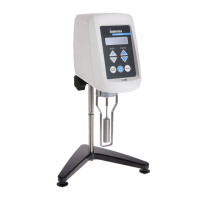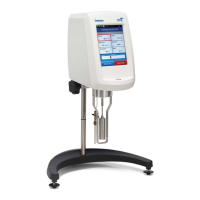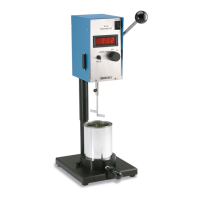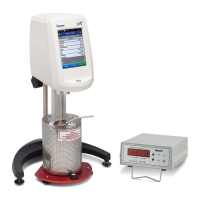Brookeld Engineering Labs., Inc. Page 61 Manual No. M/03-165-D0410
Appendix C - Variables in Viscosity Measurements
As with any instrument measurement, there are variables that can affect a Viscometer measurement.
These variables may be related to the instrument (Viscometer), or the test uid. Variables related
to the test uid deal with the rheological properties of the uid, while instrument variables would
include the Viscometer design and the spindle geometry system utilized.
Rheological Properties
Fluids have different rheological characteristics that can be described by Viscometer measurements.
We can then work with these uids to suit our lab or process conditions.
There are two categories of uids:
Newtonian - These uids have the same viscosity at different Shear Rates (different RPMs)
and are called Newtonian over the Shear Rate range they are measured.
Non-Newtonian - These uids have different viscosities at different shear rates (different
RPMs). They fall into two groups:
1) Time Independent non-Newtonian
2) Time Dependent non-Newtonian
The time dependency is the time they are held at a given Shear Rate (RPM). They are non-Newto-
nian, and when you change the Viscometer spindle speed, you get a different viscosity.
Time Independent
Pseudoplastic - A pseudoplastic material displays a decrease in viscosity with an increase
in shear rate, and is also known as “shear thinning”. If you take Viscometer
readings from a low to a high RPM and then back to the low RPM, and the
readings fall upon themselves, the material is time independent pseudoplastic
and shear thinning.
Time Dependent
Thixotropic - A thixotropic material has decreasing viscosity under constant shear rate.
If you set a Viscometer at a constant speed recording cP values over time
and nd that the cP values decrease with time, the material is thixotropic.
Brookeld publication, “More Solutions to Sticky Problems” includes a more detailed discussion of
rheological properties and non-Newtonian behavior.
Viscometer Related Variables
Most uid viscosities are found to be non-Newtonian. They are dependent on Shear Rate and the
spindle geometry conditions. The specications of the Viscometer spindle and chamber geometry
will affect the viscosity readings. If one reading is taken at 2.5 rpm, and a second at 50 rpm, the two
cP values produced will be different because the readings were made at different shear rates. The
faster the spindle speed, the higher the shear rate.

